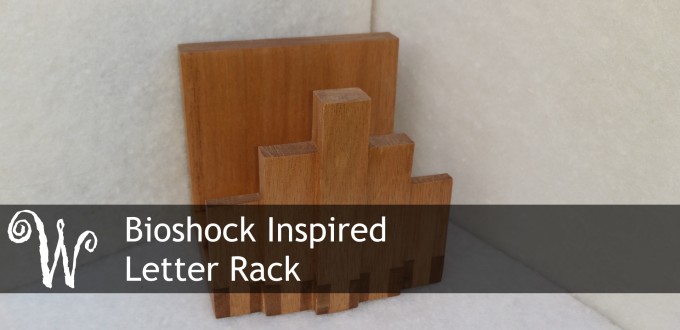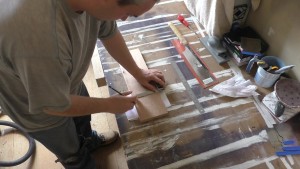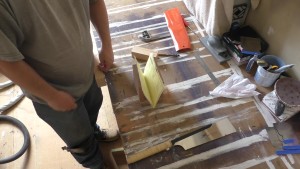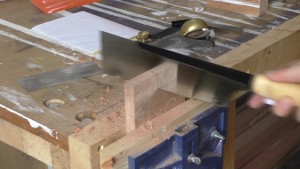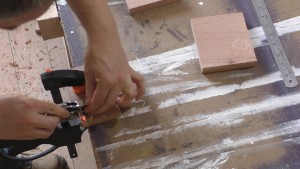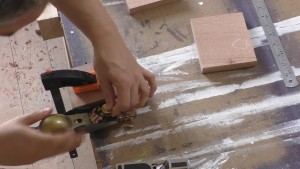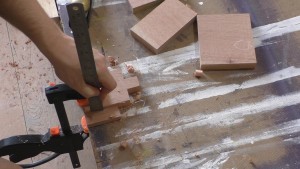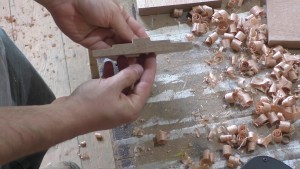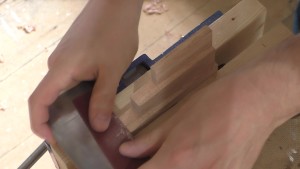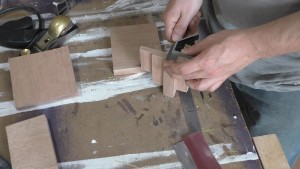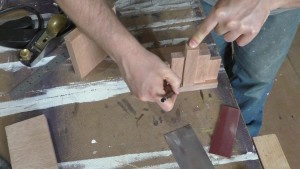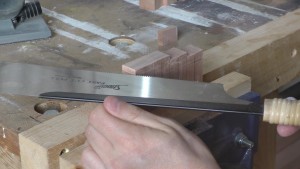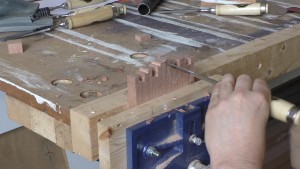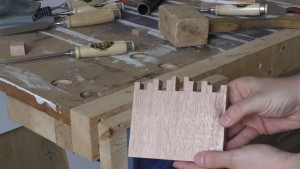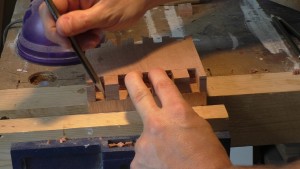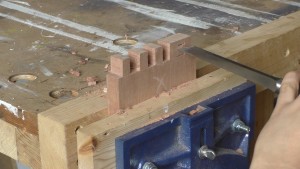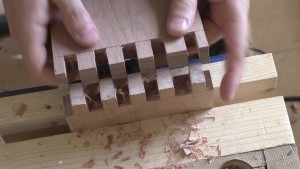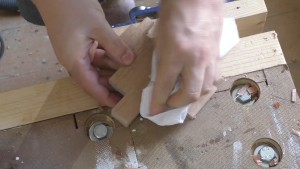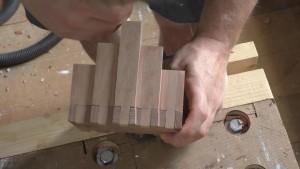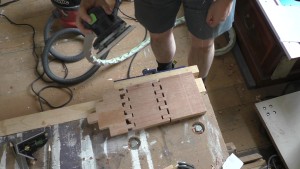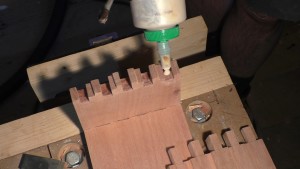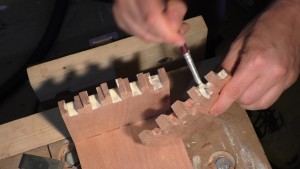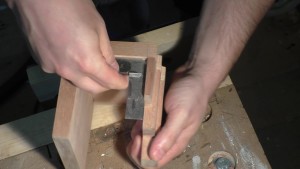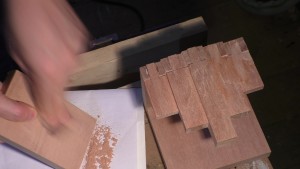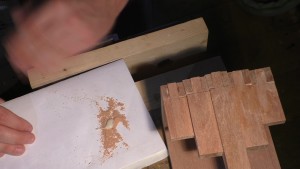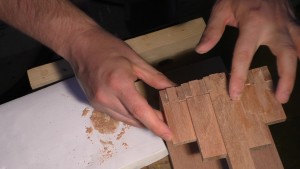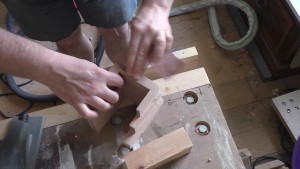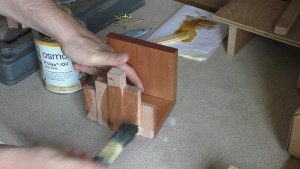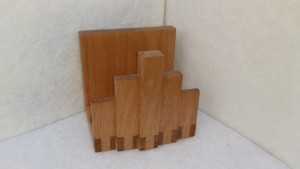I’ve recently been playing BioShock Infinite and enjoying the Art Deco architecture and I thought I’d make something that would look at home in the game. As I had a few scraps of timber left over from another job I thought I’d use those to make a letter rack.
We, like a lot of families I’d imagine, seem to gather paper work. In our case it seems to accumulate in the kitchen and takes up valuable space. A letter rack is the perfect solution to this as once it becomes full it’s a good indication that we need to do something about it!
Before starting this project I did a quick search for Art Deco style letter racks from the period. There were a few common designs but one that stood out to me was the stylized scallop or clam shell design. This was a fairly common theme but not my favourite, I wanted something that gave the shell feeling but was more abstract. After a little thought I settled on a stepped column design which is also occasionally seen in Art Deco style.
Find a board about 400mm long, 120mm wide and 20mm thick and cut off a piece about 200mm long. This piece will form the front of the letter rack. Now cut off another equal sized piece for the back. Finally cut off a section about 100mm long for the base.
When you have all the pieces cut quickly stand them all together to make sure they will hold the size of letters or paperwork you expect.
Clean up the cut edges first with a plane and then with a cabinet scraper. Don’t worry too much about breaking out the edge while planning as most of it will be cut away to achieve the final shape.
Now for the design. Divide the front piece into five equally sized sections and then working out from the centre create 20mm steps in each column.
Hold the piece in the vice and cut away the scrap. Take care to cut accurately as cleaning up any excess timber from this step is quite time consuming.
Now for the fun part where I bring the piece to life. I was really surprised how much of a difference putting in some three dimensional detail made, it went from boring and flat to alive.
Clamp a straight edged board along the line for one of the outer most columns and then using a shoulder plane create a groove 10mm deep. Once you have the groove made take out the rest of the waste with a block plane.
Check the depth as you go and refine as necessary. You’ll probably find that the two planes will leave you with a small ridge, clean this up with either a cabinet scraper or sandpaper.
Now move the guide block over to the next column and repeat the process except for making the groove only 5mm deep. When that column is finished flip the piece around and repeat the process on the other side. Finished with a light sanding.
Despite my best effort with cutting the columns I was left with a fair bit of clean up to do. I first pared away a small amount of excess material with a sharp chisel and then I used some sandpaper folder over a cabinet scraper to finish the job.
With the front complete I turned my attention to joining it to the base. I considered just gluing it as that would be more than strong enough for what it’ll be doing. I then contemplated using some small dominos and finally I settled on making work for myself by making a box joint.
A box joint has got to be one of the hardest to make by hand as it’s very unforgiving. The slightest error in position and you end up with a gap or the two pieces not fitting together. To make matters even harder for myself I decided to try and cut it using my new mortising chisels rather than the router.
Anyway, start by laying out the size of the front and back pieces on the base and then trace the shape of the front on the base. Extend the front molding lines all the way to back and then indicate the waste material.
Clamp the base in the vice and carefully saw away the waste material.
Now layout for a box joint on the base piece. I decided to go for the base end grain showing at each step on the front but the opposite configuration would also work. Your box joint should be half the width of step in the molding centred in the step. Repeat the process for the back joint on the base.
At this point you should have finished the joints on the base piece.
To cut the box joint on the back piece first clamp it in the vice and then lay the base on top of it. Using a sharp pencil transfer the box joint from the base onto the back. Don’t forget that the lines you have drawn show the edge of the wood that should remain at the end.
Now it’s just a matter of tirelessly chopping out the waste material. The process is the same as for the base. First saw down the lines and then chop out with a chisel. In this image you can see me using my new mortising chisels. They allowed me to take bigger cuts but unfortunately I didn’t consider that would mean I dented the edge of piece.
And now for the really tedious bit of box joint cutting, cleaning everything up so that it’s a nice tight fit. There really is no easy way to do this if you want a tight fit you simply have to slowly pare away a little timber at a time and repeatedly test fit until you have a joint you are happy with. With a router as suitable jigs it’s much easier.
The fitting process is exactly the same for the front piece but you have to be a lot more careful because parts of it are now quite thin. Unfortunately I went at it like a bull in a china shop and I managed to split the piece along the edge of one of the steps.
Fortunately the split didn’t go all the way through and it was on the inside so I was able to perform an invisible repair by forcing glue down into the split and then clamping it over night.
Just here though you’ll spot mistake number two. Rather than waiting for the squeeze out to dry I wiped it off with a bit of tissue. I was planning to sand the piece so I through this wouldn’t be an issue but the glue that got onto the end grain was sucked deeply into the piece and affected the final finish.
Here’s the final fit of the front joints. They aren’t bad but they aren’t exactly great either. The one on the first step on the left is probably the worst with some of the right even achieving a none to shabby.
Although I wasn’t over the moon with the joints I decided to press on and sanded the inside faces of the piece. As you can see this has cleaned up the glue residue nicely, shame I hadn’t considered the end grain.
With the inside sanded it’s time for the glue up, every woodworkers favourite bit of the job.
I decided to repair the less than perfect joints during the glue up by using the dust and glue trick. I’ve used this technique a few times with varying levels of success. I was confident of it working here because the wood is moderately dark and the glue is naturally a fair match.
Once all the surfaces are coated with glue put the piece together and correctly align everything before holding it in the vice. Grab a piece of scrap timber and start to make some dust using 80 grit sand paper. You’ll need a surprisingly large amount of dust as it’s difficult to cram it into the holes. Once you have a pile of dust mix it with just enough glue to make it workable. The less glue you use the better will be the final match to the piece. When it’s mixed use your fingers to cram the filler into the gaps. Make sure you work fast as this filler sets up quickly.
If you’ve repaired the joints on the back of the piece you can power sand everything to a nice finish. The front requires hand sanding though so get some fresh 80 grit paper and remove any excess filler.
Now using a higher girt, say 220, give everything a good sanding and then vacuum off any dust.
Finally apply a finish. I’m using an old can of Osmo Polyx Oil as I like the finish it gives, it’s sort of a cross between an oil and a polyurethane. A couple of light coats is all that is needed and the piece is done.
